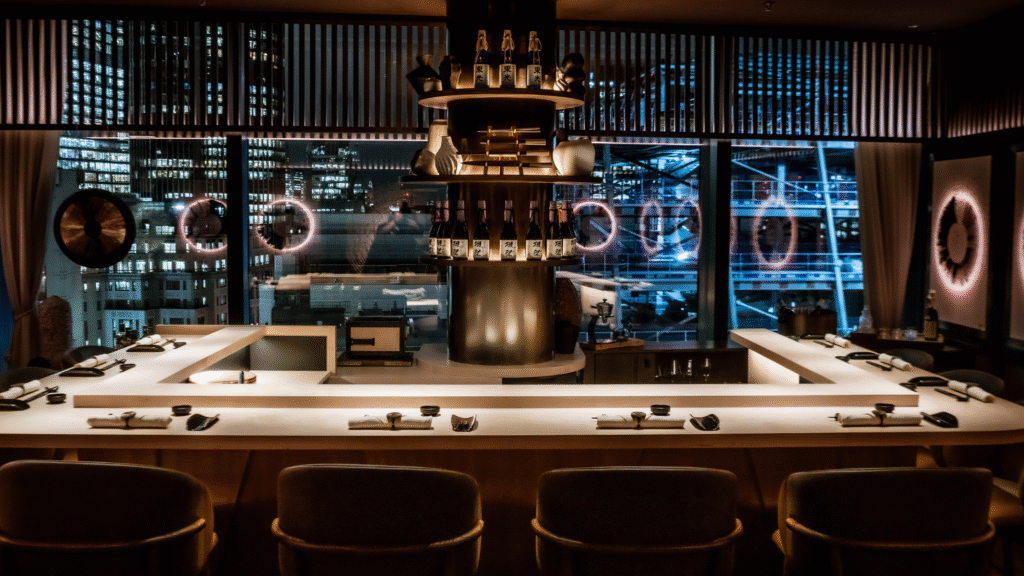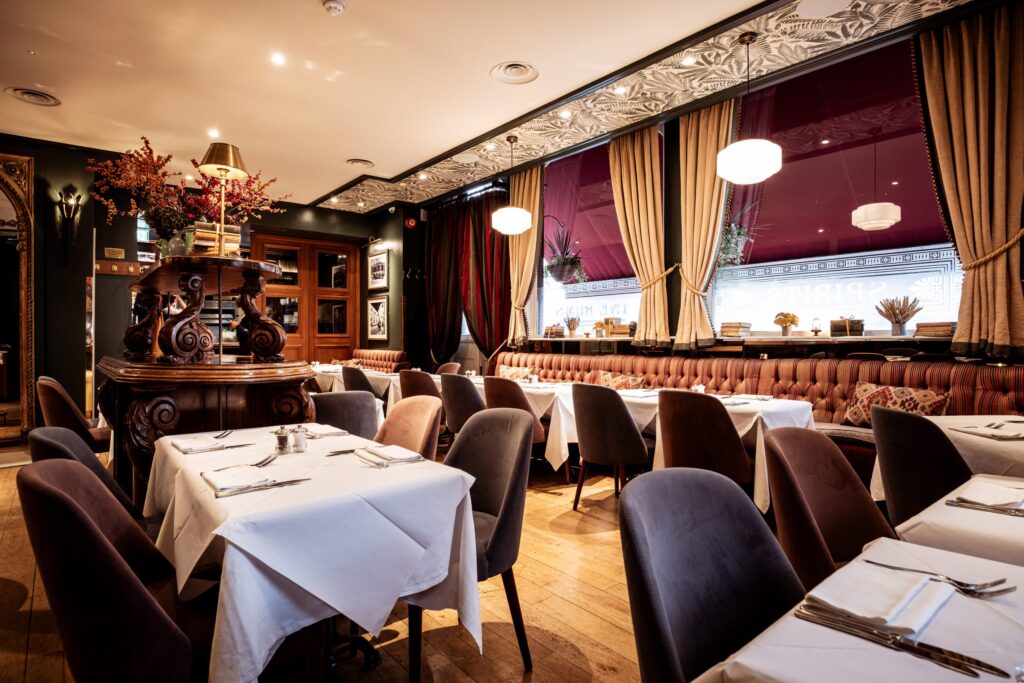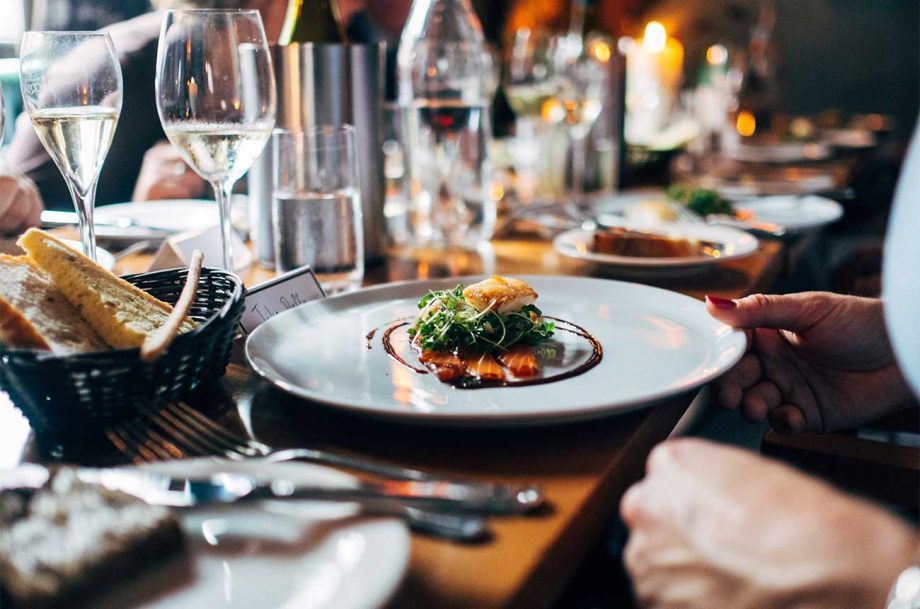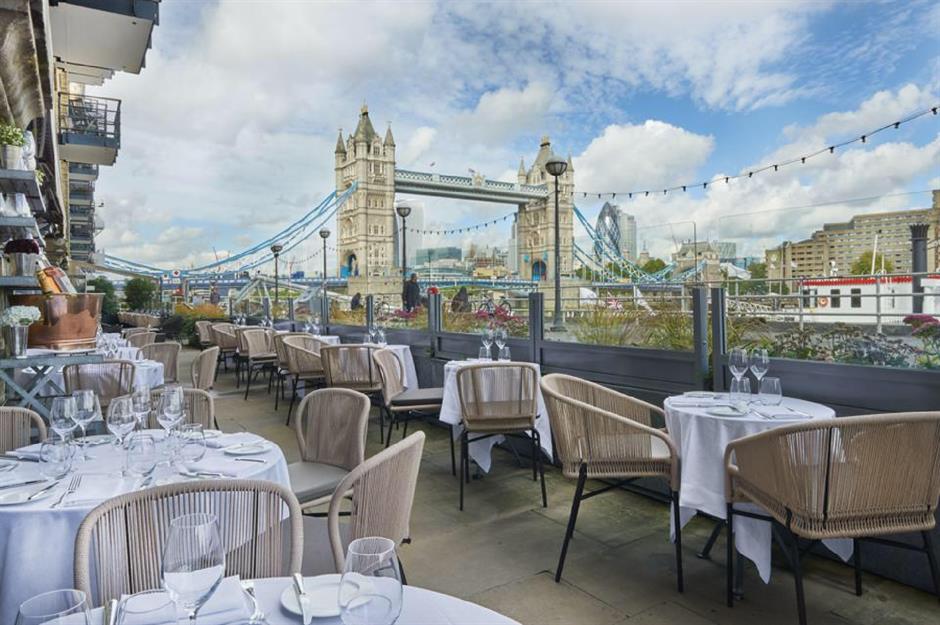The Evolution of UK Restaurants:2025
Introduction
The UK restaurant industry stands at a fascinating crossroads in 2025, balancing tradition with innovation while navigating economic challenges and changing consumer expectations. From fine dining establishments to casual eateries, restaurants across the United Kingdom are embracing technological advancements, responding to sustainability concerns, and reimagining the dining experience to stay relevant in a post-pandemic era. The sector demonstrates remarkable resilience despite facing significant headwinds, including rising operational costs, staffing shortages, and shifting consumer spending patterns. This article explores the current state of UK restaurants, highlighting key trends, challenges, and innovations shaping the culinary landscape across the nation, with particular focus on London’s influential dining scene which continues to set trends for the broader UK market

The UK Restaurant Market: Size and Scope
The UK foodservice market represents a substantial economic sector, valued at approximately $104.8 billion in 2025 with projections suggesting growth to $144.5 billion by 2030,representing a compound annual growth rate of 6.6%. Restaurants and broader foodservice businesses constitute over 52% of total hospitality revenue in 2024, underscoring their central economic role in both consumer and business spending streams. Nationally, the hospitality industry accounts for roughly 4% of UK GDP, encompassing restaurants, hotels, pubs, and leisure facilities, with total economic contribution reaching £93 billion – an increase of £20 billion over six years
London remains the highest-spending region in Great Britain, thanks to its dense population, high average incomes, and global tourism demand. The capital city is home to more than 11,400 restaurants as of 2025, ranging from quick-service outlets to high-end fine dining establishments. Activity is heavily concentrated in central and business-heavy zones such as Westminster, Camden, and Tower Hamlets, where demand remains consistently high. The UK hospitality sector overall is growing at a steady 3.5% annual rate, driven largely by consumer activity in London’s vibrant restaurant scene
Segment Breakdown: From Fine Dining to Ghost Kitchens
Fine Dining Excellence
London’s fine dining sector continues to excel, with the 2025 Michelin Guide awarding stars to 85 restaurants featuring one or more stars. This includes 10 newly awarded establishments and two elevations to two-star status. These high-end venues typically focus on tasting menus and luxury experiences, with average spend-per-head ranging from $100-250+ for dinner services. The segment is also seeing notable innovation, including the UK’s first fully vegan Michelin-starred restaurant, Plates, demonstrating how culinary innovation is gaining recognition at the highest levels 1.
Casual Dining Adjustments
The casual dining segment has faced challenges in recent years, experiencing a 4% decline in outlet numbers in 2024. This sector includes established sit-down chains like Zizzi, Ask Italian, and Prezzo, as well as modern fast-casual brands. Within London, customers typically spend £25 to £50 per meal in this segment, depending on the concept and occasion. While traditional casual dining has struggled, the fast-casual subset continues to show growth potential as consumers seek quality food with quicker service and slightly lower price points
Fast Food and Alternative Formats
Fast food continues to outpace many other segments, with the number of fast food outlets in the UK growing by 2.8% year-on-year. London accounts for over 21% of all UK delivery occasions, reflecting how deeply embedded delivery culture has become in urban life. Beyond traditional formats, street food pop-ups and food halls are reshaping how Londoners and tourists engage with food. The number of food halls across the UK has grown from 19 to 43 in under a decade, with most located in London. Market Halls—a group of food halls across multiple central locations—reported revenue growth from £8.6 million to £22 million and continues to expand
Table: London Restaurant Segment Comparison (2025)
| Segment | Outlet Growth | Average Spend | Key Characteristics |
|---|---|---|---|
| Fine Dining | Stable | £100-250+ | 85 Michelin-starred restaurants; tasting menus |
| Casual Dining | -4% (2024) | £25-50 | Declining outlets; facing increased competition |
| Fast Food | +2.8% YoY | £11-20 | Leading delivery occasions; growth continues |
| Food Halls/Street | Significant | £20-40 | From 19 to 43 UK venues in under a decade |
| Ghost Kitchens | Rapid | £20-30 delivery orders | Delivery-only; low overhead; geographic flexibility |
Emerging Consumer Trends Shaping the Industry
Health-Conscious Eating
London diners are increasingly educated and selective about their meals, with 40% of UK consumers reporting that healthy dining options drive their decisions. This has led 65% of restaurants to expand their plant-based offerings in response. High-end salad concepts like The Salad Kitchen in Canary Wharf have seen remarkable success, with revenue doubling to approximately £5 million last year, powered by demand for nutritious, customizable bowls even at premium price points. Office workers and urban professionals are particularly driving growth in formats that deliver both health benefits and convenience
Sustainability Priorities
Environmental concerns are increasingly influencing dining choices, with 49% of UK consumers willing to pay more for locally sourced meals in 2024, up from 42% in 2023. Restaurants that promote local sourcing, reduce waste, and clearly communicate their sustainability values are seeing stronger engagement, especially among younger, eco-conscious diners. Establishments that reflect environmental stewardship through practices like local sourcing, plant-based dishes, or waste reduction are establishing deeper brand loyalty and justification for premium pricing

Experiential Dining
Beyond mere sustenance, diners—especially younger demographics—increasingly seek memorable experiences that go beyond tasty food. They want ambiance, luxury, and aesthetics that are Instagram-worthy, with 61% of consumers reporting that a unique atmosphere or social experience draws them out to eat, up from 59.8% in 2022.Restaurants are responding by investing in visually compelling interiors, themed events, and immersive elements. Establishments like Sketch with its unique settings and cocktail menu, or retro-style Dishoom’s Bombay cafes, successfully combine ambience and storytelling to stand out in a competitive market
Shifting Timing Patterns
Changing work patterns have led to evolving dining schedules, with early evenings becoming the new primetime for dining in London. Industry data reports a 6% increase in reservations between 4 pm and 6 pm, driven mainly by younger diners who prefer shorter outings and flexible timing. To meet this demand, many London restaurants now offer early-bird menus, faster service models, and condensed tasting formats. This helps venues fill quieter hours, reach price-sensitive guests, and make better use of existing space without extending operating hours
Technology’s Transformative Role in UK Restaurants
Technology is fundamentally reshaping how UK restaurants operate, from ordering and payments to guest engagement and staffing. Operators are increasingly adopting tools that improve efficiency, reduce friction for guests, and provide data-backed visibility into performance across locations
Digital Integration and AI Adoption
Cloud-based POS systems have become essential for restaurants across London, connecting ordering, payments, inventory, and analytics in a single platform. This allows operators to track performance in real time and adjust service or promotions based on live data. For operators managing multiple units or hybrid service formats, these cloud-based tools enable faster order turnaround, detailed performance tracking, and seamless multi-channel ordering ecosystems
QR code menus have also seen sustained adoption, with 37% of UK diners preferring their use for restaurant payments due to the secure, fast, and contactless nature. This technology emerged strongly during the pandemic and has maintained popularity due to its convenience and operational efficiency
Artificial intelligence is making significant inroads, with 73% of UK diners comfortable with restaurants using AI tools for reservations or ordering. Nearly three-quarters (74%) of hospitality operators are already using AI, and among these, 99% have reported benefits from its implementation. AI is particularly being deployed for data analytics (over one-third of operators) and customer service functions. Restaurants using AI messaging solutions report impressive improvements: 50% increase in messages written and sent within 60 seconds, 35% more responses to reviews, and 27% faster response time to guest messages
Personalization and Marketing Technology
Personalization has become a critical competitive differentiator, with 89% of diners willing to sign up for restaurant marketing communications if it means receiving exclusive offers. Nearly half (47%) of consumers want personalized restaurant perks for birthdays and anniversaries. Restaurants are responding by using technology to deliver tailored experiences at scale
Data reveals that personalized, automated emails generate 12 times more revenue per send than mass emails. Text messaging has also proven highly effective, with 41% of consumers preferring texts from restaurants for time-sensitive messages and reservation updates. Text marketing delivers an impressive average return on investment of 24 times, generating an average of £1,391 per campaig
Investment Landscape and Future Growth Projections
Despite economic pressures, investor appetite for UK restaurants remains strong. Private equity has continued to flow into the sector over the past five years, targeting scalable concepts with strong branding and operational discipline. While there was a slight decline in private equity deals over the last couple of years, this trend appears to be rebounding in 2025
Crowdfunding has emerged as a powerful tool for smaller operators, gaining traction as a way to build customer buy-in and raise capital without relinquishing control. Notable successes include Honest Burger raising £2.9 million via Crowdcube in October 2023, MJMK Restaurants raising £2.5 million in May 2023, and Michelin-recommended Bancone raising £882,000 in December 2022. While not yet mainstream, this approach represents an untapped opportunity for many independents seeking growth capital
Today’s restaurant investors are more selective, looking for:
- Operational efficiency through lean teams and smart systems
- Tech-enabled models featuring AI-driven inventory and app-based loyalty schemes
- Unique customer experiences through unusual cuisines or immersive environments
- Robust supply chains with local sourcing and diversified suppliers
- Scalable concepts with strong potential for expansion
- Sustainability and wellness alignment in menus and operations
Challenges and Adaptations
The UK restaurant industry faces significant headwinds, including recent increases in the Minimum Wage and Employer NICs, combined with persistent inflation that continues to squeeze margins. Adding to these challenges are tightened discretionary consumer spending and high interest rates, creating an environment where survival requires more than just good food
In response, operators are implementing various strategies to maintain viability:
- Streamlining menus to reduce complexity and costs
- Renegotiating supplier contracts to improve terms
- Investing in technology to automate back-of-house operations
- Leaning into loyalty schemes and experiential marketing to retain customers
- Exploring alternative revenue streams including retail products and virtual brands
Conclusion: The Future of UK Restaurants
The most successful concepts are those that blend profit with a clear sense of purpose, engaging with their audience through strong distinctive concepts that can scale while maintaining operational leanness
The UK restaurant industry in 2025 represents a study in adaptation and resilience. Despite significant challenges, the sector continues to evolve through technology adoption, concept innovation, and responsiveness to changing consumer preferences. The enduring human desire for connection, celebration, and cultural expression through food continues to drive people to restaurants, ensuring the industry’s fundamental value proposition remains strong

Looking forward, several key themes will likely shape the continued evolution of UK restaurants:
- Greater integration of technology throughout the guest experience, from discovery to post-visit engagement
- Increased emphasis on sustainability throughout the supply chain and operations
- Continued blurring of traditional meal occasions and dining formats
- Expansion of restaurant brand extensions into retail products, experiences, and content
- Ongoing segmentation of the market with premium experiences and value offerings outperforming the middle market
For operators with vision, agility, and compelling concepts, the UK—and London in particular—remains one of the most exciting places in the world to build a restaurant brand. The challenges are significant, but so too are the opportunities for those willing to innovate while staying true to the fundamental craft of hospitality.
External Resources and Further Reading
For those interested in exploring specific aspects of the UK restaurant scene in greater depth, the following resources provide valuable insights:
- UK Restaurant Industry Trends 2025 – Comprehensive research on how brands are using technology to deepen customer relationships
- https://sjxsm.shop/the-ultimate-guide-to-the-warehouse-associate/#google_vignette
- London Restaurant Industry Statistics 2025 – Detailed market data and performance metrics for London’s dining scene
- The London Restaurant Industry in 2025 – Analysis of investment trends and economic pressures facing capital restaurants
- National Restaurant Awards – Guide to the UK’s best restaurants and award winners
- UK Menu Trends: Spring/Summer 2025 – Mintel’s analysis of menu trends across UK foodservice venues (report available for purchase)
- Restaurants and Bars Report 2025 – BDO’s comprehensive report on how operators are adapting to changing market conditions

